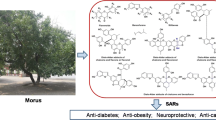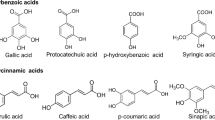Abstract
Eugenol (4-allyl-2-methoxyphenol) is a volatile phenolic bioactive compound derived from a natural resource. This compound has been identified in several aromatic plants, among which Syzygium aromaticum (L.) Merr. and L.M. Perry contains between 45 and 90% of eugenol in its essential oil compared to other natural sources. Eugenol has been studied over the years and has shown to display a wide range of biological activities as antifungal, antimicrobial, anti-inflammatory, antioxidant, analgesic, anticancer, and antiparasitic. It has been extensively used in cosmetics, in food processing industry, and also as a starting material for total synthesis of several natural products. The 4-allyl-2-methoxyphenol has a simple structure, which presents three active sites: hydroxyl, allylic, and aromatic groups. Thus, the chemistry of this natural component emphasizes its potential impact in the synthesis of novel drugs, compounds that can be useful for human resources. Therefore, the present article reviews the latest developments in the methodologies of synthesis, pharmacological properties, and further applications of eugenol derivatives.






























Similar content being viewed by others
References
Kfoury M, Fourmentin S, Auezova L, Greige-Gerges H. Effets des substituants de phénylpropènes sur la stabilité d’encapsulation dans les cyclodextrines. Leban Sci J. 2015;16:107–16.
Vogt T. Phenylpropanoid biosynthesis. Mol Plant. 2010;3:2–20. https://doi.org/10.1093/mp/ssp106.
Kaufman TS. The multiple faces of Eugenol. A versatile starting material and building block for organic and bio-organic synthesis and a convenient precursor toward bio-based fine chemicals. J Braz Chem Soc. 2015;26:1055–85. https://doi.org/10.5935/0103-5053.20150086.
Barceloux DG. Medical toxicology of natural substances. Hoboken, NJ: Foods, Fungi, Medicinal Herbs, Plants and Venomous Animals; 2008.
Guenette SA, Beaudry F, Marier JF, Vachon P. Pharmacokinetics and anesthetic activity of eugenol in male Sprague-Dawley rats. J Vet Pharm Ther. 2006;29:265–70. https://doi.org/10.1111/j.1365-2885.2006.00740.x.
Daniel AN, Sartoretto SM, Schmidt G, Caparroz-Assef SM, Bersani-Amado CA, Cuman RKN. Anti-inflammatory and antinociceptive activities of eugenol essential oil in experimental animal models. Braz J Pharmacogn. 2009;19:212–7. https://doi.org/10.1590/S0102-695X2009000200006.
Lahlou S, Figureueiredo AF, Magalhães PJC, Leal-Cardoso JH, Gloria PD. Cardiovascular effects of methyleugenol, a natural constituent of many plant essential oils, in normotensive rats. Life Sci. 2004;74:2401–12. https://doi.org/10.1016/j.lfs.2003.09.063.
Zheng GQ, Kenney PM, Lam LKT. Sesquiterpenes from clove (Eugenia caryophyllata) as potential anticarcinogenic agents. J Nat Prod. 1992;55:999–1003. https://doi.org/10.1021/np50085a029.
Hidalgo ME, De la Rosa C, Carrasco H, Cardona W, Gallardo C, Espinoza L. Antioxidant capacity of eugenol derivatives. Quim Nova. 2009;32:1467–70. https://doi.org/10.1590/S0100-40422009000600020.
Machado M, Dinis AM, Salgueiro L, Custódio JBA, Cavaleiro C, Sousa MC. Anti-Giardia activity of Syzygium aromaticum essential oil and eugenol: effects on growth, viability, adherence and ultrastructure. Exp Parasitol. 2011;127:732–9. https://doi.org/10.1016/j.exppara.2011.01.011.
Pinto E, Vale-Silva L, Cavaleiro C, Salgueiro L. Antifungal activity of the clove essential oil from Syzygium aromaticum on Candida, Aspergillus and Dermatophyte species. J Med Microbiol. 2009;58:1454–62. https://doi.org/10.1099/jmm.0.010538-0.
Yadav MK, Chae SW, Im GJ, Chung JW, Song JJ. Eugenol: a phyto-compound effective against methicillin-resistant and methicillin-sensitive Staphylococcus aureus clinical strain biofilms. PLoS ONE. 2015;10:1–21. https://doi.org/10.1371/journal.pone.0119564.
Wang C, Fan Y. Eugenol enhances the resistance of tomato against tomato yellow leaf curl virus. J Sci Food Agric. 2014;94:677–82. https://doi.org/10.1002/jsfa.6304.
Dos Santos T, Coelho C, Elias TC, Siqueira FS, Nora ESSD, De Campos MMA, et al. Synthesis and biological evaluation of new eugenol-derived 1,2,3-triazoles as antimycobacterial agents. J Braz Chem Soc. 2019;30:1425–36. https://doi.org/10.21577/0103-5053.20190038.
Ginting M, Surbakti D, Triana N. Synthesis of 2-(4-Allyl-2-methoxy phenoxy)-N,N-Bis(2-hydroxyethyl) acetamide from the transformation of eugenol isolated from clove oil. J Chem Nat Resour. 2019;1:1–9.
Eyambe G, Canales L, Bimal KB. Antimicrobial activity of eugenol derivatives. 2011;11:10–14. https://doi.org/10.16194/j.cnki.31-1059/g4.2011.07.016.
Da Silva FFM, Monte FJQ, De Lemos TLG, Do Nascimento PGG, Costa AKM, De Paiva LMM. Eugenol derivatives: synthesis, characterization, and evaluation of antibacterial and antioxidant activities. Chem Cent J. 2018;12:1–9. https://doi.org/10.1186/s13065-018-0407-4.
Topal F, Gulcin I, Dastan A, Guney M. Novel eugenol derivatives: potent acetylcholinesterase and carbonic anhydrase inhibitors. Int J Biol Macromol. 2017;94:845–51. https://doi.org/10.1016/j.ijbiomac.2016.10.096.
Devkate SS, Burungale AS, Jadhav SD, Pise AS, Gawde RB. Synthesis of γ-lactones by nucleophilic addition of carboxylic acid enediolates to epoxides. J Emerg Technol Innov Res. 2019;6:738–42. https://doi.org/10.1729/Journal.19845.
Melean LG, Rodriguez M, Romero M, Alvarado ML, Rosales M, Baricelli PJ. Biphasic hydroformylation of substituted allylbenzenes with water-soluble rhodium or ruthenium complexes. Appl Catal A Gen. 2011;394:117–23. https://doi.org/10.1016/j.apcata.2010.12.037.
Lauro F, Cedillo D, Marcela R. Design and synthesis of a diaza-bicyclo-naphthalen-oxiranyl-methanone derivative. Theoretical analysis of their interaction with cytochrome P450-17A1. Chem Methodol. 2019;3:194–210. https://doi.org/10.22034/chemm.2018.147492.1083.
Lenardão EJ, Jacob RG, Mesquita KD, Lara RG, Webber R, Martinez DM, et al. Glycerol as a promoting and recyclable medium for catalyst-free synthesis of linear thioethers: new antioxidants from eugenol. Green Chem Lett Rev. 2013;6:269–76. https://doi.org/10.1080/17518253.2013.811298.
Farias AM, Oliveira PS, Dutra FSP, Fernandes TJ, De pereira CMP, De Oliveira SQ, et al. Eugenol derivatives as potential anti-oxidants: is phenolic hydroxyl necessary to obtain an effect? J Pharm Pharmacol. 2014;66:733–46. https://doi.org/10.1111/jphp.12197.
Martins RM, Farias MDA, Nedel F, De Pereira CMP, Lencina C, Lund RG. Antimicrobial and cytotoxic evaluation of eugenol derivatives. Med Chem Res. 2016;25:2360–7. https://doi.org/10.1007/s00044-016-1682-z.
Nurul HCAR, Asnuzilawati A, Noraznawati I, Hasnah O. Synthesis and antibacterial study of eugenol derivatives. Asian J Chem. 2017;29:22–6. https://doi.org/10.14233/ajchem.2017.20100.
Ngadiwiyana I, Gunawan SPR, Prasetya NBA, Kusworo TD, Susanto H. One pot reaction to synthesize allyl etherified eugenol from clove oil. IOP Conf Ser Mater Sci Eng. 2019;509. https://doi.org/10.1088/1757-899X/509/1/012098.
Bkhaitan MM, Alarjah M, Mirza AZ, Abdalla AN, El-Said HM, Faidah HS. Preparation and biological evaluation of metronidazole derivatives with monoterpenes and eugenol. Chem Biol Drug Des. 2018;92:1954–62. https://doi.org/10.1111/cbdd.13366.
Srivastava KC, Malhotra N. Acetyl eugenol, a component of oil of cloves (Syzygium aromaticum L.) inhibits aggregation and alters arachidonic acid metabolism in human blood platelets. Prostaglandins Leukot Essent Fat Acids. 1991;42:73–81. https://doi.org/10.1016/0952-3278(91)90070-L.
De Almeida AL, Ferracioli CKR, De Scodro RB, Baldin VP, Montaholi DC, Spricigo LF, et al. Eugenol and derivatives activity against Mycobacterium tuberculosis, Nontuberculous mycobacteria and other bacteria. Future Microbiol. 2019;14:331–44. https://doi.org/10.2217/fmb-2018-0333.
Awasthi PK, Dixit SC, Dixit N, Sinha AK. Eugenol derivatives as future potential drugs. J Pharm Res. 2008;1:215–20.
Bansode TN. Green synthesis and antimicrobial activity of some eugenol derivatives. J Chem Pharm Res. 2017;9:145–7.
Bilgiçli HG, Kestane A, Taslimi P, Karabay O, Damoni AB, Zengin M, et al. Novel eugenol bearing oxypropanolamines: synthesis, characterization, antibacterial, antidiabetic, and anticholinergic potentials. Bioorg Chem. 2019;88:1–7. https://doi.org/10.1016/j.bioorg.2019.102931.
Ahmad A, Wani MY, Khan A, Manzoor N, Molepo J. Synergistic interactions of eugenol-Tosylate and its congeners with fluconazole against Candida albicans. PLoS ONE. 2015;10:1–19. https://doi.org/10.1371/journal.pone.0145053.
Elgendy EM, Khayyat SA. Oxidation reactions of some natural volatile aromatic compounds: anethole and eugenol. Russ J Org Chem. 2008;44:823–9. https://doi.org/10.1134/s1070428008060079.
Maurya AK, Agarwal K, Gupta AC, Saxena A, Nooreen Z, Tandon S, et al. Synthesis of eugenol derivatives and its anti-inflammatory activity against skin inflammation. Nat Prod Res. 2018;0:1–10. https://doi.org/10.1080/14786419.2018.1528585.
Carrasco H, Raimondi M, Svetaz L, Di Liberto M, Rodriguez VM, Espinoza L, et al. Antifungal activity of eugenol analogues. Influence of different substituents and studies on mechanism of action. Molecules. 2012;17:1002–24. https://doi.org/10.3390/molecules17011002.
Hipólito TMM, Bastos GTL, Barbosa TWL, De Souza TB, Coelho LFL, Dias ALT, et al. Synthesis, activity, and docking studies of eugenol-based glucosides as new agents against Candida sp. Chem Biol Drug Des. 2018;92:1514–24. https://doi.org/10.1111/cbdd.13318.
Sudarma IM, Wazni N, Wildawaty N, Yuanita E, Suana IW. An efficient method on nitration of eugenol using NH4NO3 and KHSO4. Asian J Chem. 2014;26:173–5. https://doi.org/10.14233/ajchem.2014.15367.
Chen CH, Tung SH, Jeng RJ, Abu Omar MM, Lin CH. A facile strategy to achieve fully bio-based epoxy thermosets from eugenol. Green Chem. 2019;21:4475–88. https://doi.org/10.1039/c9gc01184f.
Qin J, Liu H, Zhang P, Wolcott ZJ. Use of eugenol and rosin as feedstocks for biobased epoxy resins and study of curing and performance properties. Polym Int. 2013;63:760–5. https://doi.org/10.1002/pi.4588.
Yadav RN, Banik KB. Studies on natural products: a facile epoxidation of eugenol. Mod Chem Appl. 2018;06:254–5. https://doi.org/10.4172/2329-6798.1000255.
Hamri BS, Rhazri K, Hafid A, Ouchetto H, Hajbi Y. Clove (Eugenia Caryophyllata) extraction and synthesis of new pyrazole derivatives from eugenol. Glob J Sci Front Res Chem. 2013;13:1–6.
Sohilait HJ, Kainama H. Free radical scavenging activity of essential oil of Eugenia caryophyllata from amboina island and derivatives of eugenol. Open Chem. 2019;17:422–8. https://doi.org/10.1515/chem-2019-0047.
Sudarma IM, Kusnandini A, Darmayanti MG. Chemical transformation of eugenol isolated from leaves of Syzygium aromaticum to its new isothiocyanate derivatives. J Nat Prod. 2015;8:27–32.
Kumar N, Yadav N, Amarnath N, Sharma V, Shukla S, Srivastava A, et al. Integrative natural medicine inspired graphene nanovehicle-benzoxazine derivatives as potent therapy for cancer. Mol Cell Biochem. 2019;454:123–38. https://doi.org/10.1007/s11010-018-3458-x.
Dongarwar AS, Wanjari BE, Nema MV, Khan MSY. Synthesis, anti-inflammatory and anti-microbial activity of some new 1-(3-phenyl-3,4-dihydro-2H-1,3-benzoxazin-6-yl) ethanone derivatives. Int J Biomed Adv Res. 2011;2:101–4. https://doi.org/10.7439/ijbar.v2i6.33.
Hayawaka I, Hiramitsu T, Tanaka Y. Benzoxazine derivatives. US4382892. 1983 May 10.
Gemma S, Camodeca C, Brindisi M, Brogi S, Kukreja G, Kunjir S, et al. Mimicking the intramolecular hydrogen bond: synthesis, biological evaluation, andmolecular modeling of benzoxazines and quinazolines as potential antimalarial agents. J Med Chem. 2012;55:10387–404. https://doi.org/10.1021/jm300831b.
Rudyanto M, Ekowati J, Widiandani T, Honda T. Synthesis and brine shrimp lethality test of some benzoxazine and aminomethyl derivatives of eugenol. Int J Pharm Pharm Sci. 2014;6:96–8.
Abrão PHO, Pizi RB, De Souza TB, Silva NC, Fregnan AM, Silva FN, et al. Synthesis and biological evaluation of new eugenol Mannich bases as promising antifungal agents. Chem Biol Drug Des. 2015;86:459–65. https://doi.org/10.1111/cbdd.12504.
Coelho CM, Dos Santos T, Freitas PG, Nunes JB, Marques MJ, Padovani CGD, et al. Design, synthesis, biological evaluation and molecular modeling studies of novel eugenol esters as leishmanicidal agents. J Braz Chem Soc. 2018;29:715–28. https://doi.org/10.21577/0103-5053.20170192.
De Souza TB, Orlandi M, Coelho LFL, Malaquias LCC, Dias ALT, De Carvalho RR, et al. Synthesis and in vitro evaluation of antifungal and cytotoxic activities of eugenol glycosides. Med Chem Res. 2014;23:496–502. https://doi.org/10.1007/s00044-013-0669-2.
De Souza TB, De Oliveira BKM, Silva NC, Rocha RP, De Sousa GF, Duarte LP, et al. New eugenol glucoside-based derivative shows fungistatic and fungicidal activity against opportunistic Candida glabrata. Chem Biol Drug Des. 2016;87:83–90. https://doi.org/10.1111/cbdd.12625.
Prasetya NBA, Ngadiwiyana I, Sarjono PR. Synthesis and study of antibacterial activity of polyeugenol. IOP Conf Ser Mater Sci Eng. 2019;509. https://doi.org/10.1088/1757-899X/509/1/012101.
Prasetya NBA, Ngadiwiyana I, Sarjono PR. Synthesis of copolymer eugenol crosslinked with divinyl benzene and preliminary study on its antibacterial activity. IOP Conf Ser Mater Sci Eng. 2019;509. https://doi.org/10.1088/1757-899X/509/1/012102.
Rahim EA, Sanda F. Synthesis and functionality of eugenol-based polyacetylenes. J Phys Conf Ser. 2019;1242. https://doi.org/10.1088/1742-6596/1242/1/012003.
Rojo L, Vasquez B, Parra J, Bravo AL, Deb S, Roman JS. From natural products to polymeric derivatives of “eugenol”: a new approach for preparation of dental composites and orthopedic bone cements. Biomacromolecules. 2006;7:2751–61. https://doi.org/10.1021/bm0603241.
Liu K, Madbouly SA, Kessler MR. Biorenewable thermosetting copolymer based on soybean oil and eugenol. Eur Polym J. 2015;69:16–28. https://doi.org/10.1016/j.eurpolymj.2015.05.021.
Yupeing L, Luo F, Cheng C. Preparation of eugenol-based polyurethane. IOP Conf Ser Mater Sci Eng. 2018;322:5–9. https://doi.org/10.1088/1757-899X/322/2/022030.
Funding
Financial support from University Hassan II of Casablanca is gratefully acknowledged.
Author information
Authors and Affiliations
Contributions
MD: writing original draft and visualization; AA: writing review; AE: analysis and interpretation of data; AEA: methodology and investigation, JJ: reviewed the final paper.
Corresponding author
Ethics declarations
Conflict of interest
The authors declare no competing interests.
Consent to publish
All authors are agreeing for publishing in your journal. We confirm that the paper has been read and approved and that there are no other persons who satisfied the criteria for authorship but are not listed. We further confirm that the order of authors listed in the paper has been approved.
Additional information
Publisher’s note Springer Nature remains neutral with regard to jurisdictional claims in published maps and institutional affiliations.
Rights and permissions
About this article
Cite this article
Abdou, A., Elmakssoudi, A., El Amrani, A. et al. Recent advances in chemical reactivity and biological activities of eugenol derivatives. Med Chem Res 30, 1011–1030 (2021). https://doi.org/10.1007/s00044-021-02712-x
Received:
Accepted:
Published:
Issue Date:
DOI: https://doi.org/10.1007/s00044-021-02712-x




